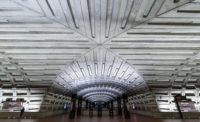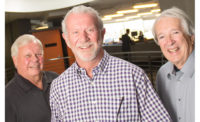Obituary
Clyde Baker, Deep Foundation Innovator, Dies at 92
Geotechnical engineer was the 2008 ENR Award of Excellence recipient

Clyde Baker was an innovator in deep foundations for supertall buildings.
Cover image courtesy of ENR Archives
If structural engineers of supertall buildings have slept soundly over the last half century, it is likely in part thanks to Clyde N. Baker Jr., a geotechnical engineer who advanced the science of soil and deep foundation design.
Baker, 92, who was the ENR Award of Excellence Winner in 2008, died Aug. 26.
Baker had a role in designing or in peer reviewing some of the world’s tallest skyscrapers, many of which were height recordsetters. These include the current world's tallest, the 828-m Burj Khalifa in Dubai, the Petronas Towers in Kuala Lumpur, 101 Financial Center in Taipei, the Doha Convention Center and Tower in Qatar and Incheon 151 Towers in Incheon, South Korea. In Chicago, he left his deep mark on the Sears Tower, now named Willis Tower; Trump Tower; the John Hancock Building; and the Amoco Building.
The engineer also was a leader in using in-situ testing techniques correlated with past building performance to develop more efficient foundation designs.
"Baker is a strong foundation of experience, having spent 54 years at Vernon Hills, Ill.-based [consultant] STS-AECOM applying soil theory, in-the-ground testing, instrumentation and careful observation to bring up the science of soils from a crying baby to a responsible adult," said ENR in its April 2, 2008, cover story on the innovator.
Multidisciplinary consultant Skidmore, Owings & Merrill engaged Baker, who called himself “pre-computer,” to provide peer review of the 12-year-old Burj Khalifa, which SOM designed.
Smart Enough To Make Things Simple
“He was smart enough to make things simple,” says Bill Baker, a consulting partner with SOM in Chicago who was the structural engineer in charge of the Burj and is not related to Clyde. “He could see the essence of a problem.”
Adds SOM's Baker: “He did a calculation on a page and a half that was very close to the actual settlements of the building. The more official calculations were all of these computer printouts and other stuff.”
Born in New York City's Flushing, Queens, section in 1930, Baker, as a young man, suffered from rheumatoid arthritis, which prompted him to drop out of college for a semester. After experimental cortisone treatment improved his health, he earned a physics degree from the College of William & Mary and a master’s degree in geotechnical engineering from the Massachusetts Institute of Technology. He worked at MIT in the Soils Stabilization Laboratory and took classes with Karl Terzaghi, known as the father of soil mechanics.
Baker’s first job out of college was at Chicago-based STS Consultants, where he rose to president and principal before it was purchased by AECOM. He joined GEI Consultants outside Chicago in 2014.
“For bored piles founded on soil, Baker has pushed bearing pressures in Chicago 400%, while rock-socketed caissons have increased 50%. This track record has made Baker useful in cities building super tall,” states the ENR Award of Excellence article.
Test methods that Baker implemented in Chicago helped prove that soil and bedrock can safely support big loads.
For the Jeddah Tower in Saudi Arabia, currently under construction but planned to rise at least 1,000 m, Baker performed a peer review for the Chicago office of project structural engineer, Thornton Tomasetti. TT says his input greatly influenced whether the project went forward.
“Sometimes if people start questioning the design, it brings the whole thing to a stop,” says Robert Sinn, a former TT principal. “As soon as we brought Clyde in, all of a sudden, as long as he was comfortable with it, we were good to go.”
Despite many professional accolades, SOM's Baker and Sinn agree that Baker was humble and not above pitching in as needed.
SOM's Baker recalls working with Baker on a project on the busy streets of Chicago’s Loop. The contractor had dug an 80-ft-deep hole when the pumps stopped. Water was in danger of seeping into the excavation.
“Clyde starts personally directing the concrete trucks to back up and get the concrete in before water starts getting in,” says Baker. “Clyde just took charge. It wasn’t his problem, but if he hadn’t done that, there was going to be a problem."
Many engineers are conservative to protect themselves from liability, adds Baker. "Clyde would be pretty aggressive but we never got in trouble," he says.
Bernie Hertlein, senior consultant at GEI, worked with Baker for 30 years and considered him a friend and mentor. “He was an outstanding engineer,” Hertlein says. “He was open-minded and willingly embraced change and new ideas. Above all he was just a gentleman and a very generous soul.”
One example of his generosity and stamina was that, as a longtime marathon runner, Baker ran 60 miles on his 60th birthday, raising $10,000 for Alzheimer’s research.
Sinn says: "He's going to be so hard to replace."




